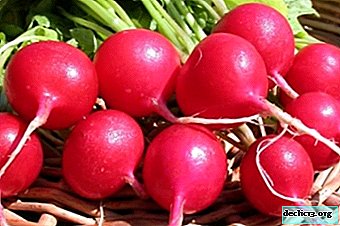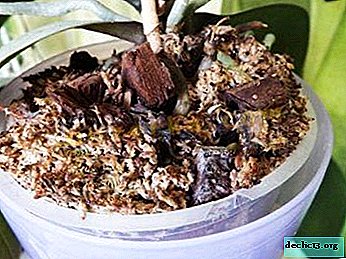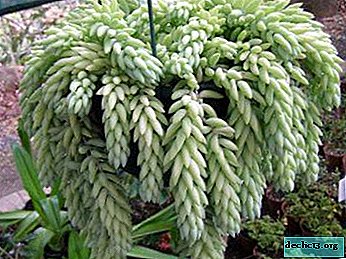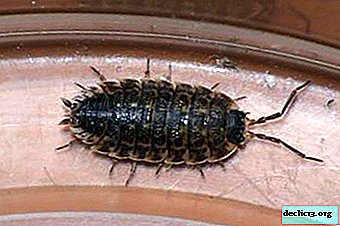Sax radish variety RS. Distinctive features, the rules of cultivation, harvesting and storage of crops

Radish is one of the earliest popular vegetables. An unpretentious, vitamin root crop can grow any gardener, only some rules should be taken into account.
And if you need a rich harvest, and even more than once a season, then the Saks variety is what you need.
In the article we will tell in detail about how this variety differs from others and give recommendations for its cultivation and storage.
Description, description and photo of the variety
Saksa variety - early ripening, unpretentious, but at the same time a high-yielding look. Matures quickly and simultaneously, has a compact outlet with small foliage.
- Appearance. Round small root crop, bright red, slightly flattened. The fruits are juicy, dense, with a pleasant bitterness.
- Sowing time. "Sax" is a medium - early variety, planted most often in April. Root crops ripen amicably and quickly.
- The average weight of 1 radish. Root crops weigh from 5 to 10 grams.
- Productivity Depending on the region of zoning, weather, productivity fluctuates. From 1 square, 1 to 4 kg of vegetable is collected.
- Where to grow? The variety can be grown in open and closed ground, in the crates of the house.
- Resistance to diseases and pests. Radish of this variety is not prone to bloom, flabbiness, but suffers from common cruciferous diseases. Not affected by powdery mildew.
- Ripening period. The first radish ripens about a month after planting.
- The soil. He loves light, fertile soils. The most suitable time for planting in damp earth, after the snow has melted.
- Harvest time. The crop is well preserved, can lie up to several weeks.
Next, you can see a photo of a vegetable of this variety.



Breeding History
Saksa variety was bred at the All-Russian Research Institute of Selection and Seed Production of Vegetable Crops. The variety was zoned in 1949. The State Register registered this variety in 2007 as Sachs RS.
Unlike other varieties
- It tolerates long daylight hours.
- Suitable areas on the sunny side and shaded.
- Planted with squares of 5 by 10 cm.
- Likes well-moistened soils, responsive to light.
Advantages and disadvantages
Grade advantages:
- High yielding.
- It is possible to grow all year.
- Planted in early spring, immediately after the snow melts.
- Seeds are cheap, they germinate up to 2 years.
- Tasty, juicy.
- Non-GMO, safe.
Disadvantages:
- It requires constant watering.
- The soil must be moist.
Why and where is it used?

- It is most often used fresh, in salads, but Sax can be preserved.
- It is used as a medicine for colds, fungi, gallstones.
- Gardeners often plant it in mixed plantings to delimit crops.
Radishes are also edible in radishes.
Having diseases of the liver, kidneys, gastric ulcer, gastritis, caution should be used in food radishes.
Growing
Growing radishes is easy. To land, select a site on the sunny side. Soils fit light, fertile. They plant it early, as soon as the snow falls in late March - early April. It can be re-planted in late July - early August. The soil for planting is prepared in the fall. Phosphate and potassium fertilizers, humus, peat are added to it.
Attention! You can not plant radishes in manure, after cabbage, radish. Favorable areas after tomato, cucumbers.The most common method of planting is seed. Planted in moist ground. For quick and friendly germination, the seeds should be warmed up and germinated. Before planting, you can put +45 degrees in water for 15 minutes or use growth stimulants to soak. Then the seeds are dried. Seeds are closed to a depth of 1-1.5 cm. Aisles -10-12 cm. Do not allow thickening. Seedlings are thinned out so that between seedlings is 5-6 cm.
Leaving consists in watering and top dressing. The optimum temperature is -20 degrees. The soil should always be moist. If the heat is 30 degrees and above, then watering should be provided twice a day.
For the formation of root crops, a plant needs 10-12 hours a day. Therefore, it is useful to shade landings from 8 o’clock in the evening to 8 o’clock in the morning.
The first crop is harvested after about three weeks or 28 days.
Harvesting and storage
Harvesting is carried out selectively: first large fruits, then after a week or two - grown radish. Two weeks later, the harvest of radishes ends. Before harvesting, the soil is moistened and pulled out by root crops. They are cleaned of tops, cut tails. Well stored in the refrigerator in a plastic bag for up to a week.
Diseases and Pests
 The variety is resistant to powdery mildew, but suffers from all cruciferous diseases.
The variety is resistant to powdery mildew, but suffers from all cruciferous diseases.
- Protect young growth from cabbage fleas and flies. To do this, use tobacco dust and ash or the chemical drug "Actofit". Means are washed off by rain or during watering, so the treatment is carried out again after 3-4 days. You can use anti-flea shampoo, covering material, traps with sweet syrup. From cabbage flies, fleas, you can plant odorous plants in the aisles: parsley, coriander, marigolds.
- Another disease of radish is white rust. Leaves are covered with white coating, dry. Treat plantings once a week with a strong solution of potassium permanganate, soda ash or baking soda, colloidal sulfur.
- All cruciferous can get a black leg. This disease is best avoided on its site, because the plants affected by it die and must be destroyed. Preventive measures should be taken:
- Prevent waterlogging of the soil.
- Soak the seeds in the infusion of garlic or potassium permanganate.
- Treat the soil with a solution of colloidal sulfur, boiling water.
- Sprinkle plants with charcoal, ash, chalk.
- Periodically pour with a solution of onion husks, marigold greens, a weak solution of Fitosporin-M.
Similar varieties
A number of varieties resemble Saksa. They also apply to early ripening varieties. It:
- French breakfast.
- Firstborn F1.
- Sora.
- Heat.
- Rondar.
They are characterized not only by early and friendly maturation, they are unpretentious, resistant to shooting, flowering, and cracking.
If you want to please yourself and your family with a harvest of early radishes, and at the same time not to spend a lot of effort, then plant Sax. You will always be with a dietary vitamin vegetable.
Interesting video
We offer a video with a description and characteristics of the Sachs RS radish variety:

















